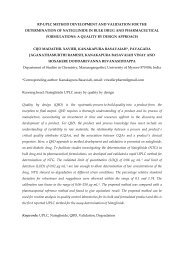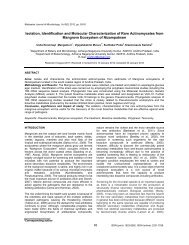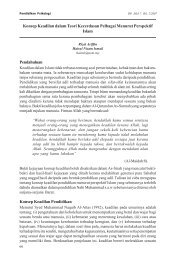"Acceptability" in the Translation into Malay of Rihlat Ibn ... - USM
"Acceptability" in the Translation into Malay of Rihlat Ibn ... - USM
"Acceptability" in the Translation into Malay of Rihlat Ibn ... - USM
You also want an ePaper? Increase the reach of your titles
YUMPU automatically turns print PDFs into web optimized ePapers that Google loves.
"Acceptability" <strong>in</strong> <strong>the</strong> <strong>Translation</strong> <strong>of</strong> <strong>Rihlat</strong> <strong>Ibn</strong> Battutah 5<br />
In this framework, Holmes differentiates between "pure" translation research,<br />
which conta<strong>in</strong>s two major classifications ("<strong>the</strong>oretical" and "descriptive"), and<br />
"applied" translation studies (pp. 71–79). However, even though <strong>the</strong>y are three<br />
dist<strong>in</strong>ct branches <strong>of</strong> <strong>the</strong> discipl<strong>in</strong>e, <strong>the</strong>ir functions are <strong>in</strong>terrelated. This is because<br />
<strong>the</strong> description <strong>of</strong> translation provides <strong>the</strong> basic data by which translation <strong>the</strong>ory<br />
can be identified. These translation descriptions and <strong>the</strong>ories <strong>of</strong>fer certa<strong>in</strong><br />
f<strong>in</strong>d<strong>in</strong>gs that can be used <strong>in</strong> applied translation <strong>the</strong>ories.<br />
Based on this framework, Toury (1980; 1995) developed a method for descriptive<br />
translation studies (DTS). Toury considered <strong>the</strong> map <strong>of</strong> translation studies (see<br />
Figure 1) as a basic pr<strong>in</strong>ciple <strong>of</strong> translation studies. This functioned as <strong>the</strong> start<strong>in</strong>g<br />
po<strong>in</strong>t for his stance that <strong>the</strong> discipl<strong>in</strong>e should emerge as an empirical science,<br />
argu<strong>in</strong>g that "no empirical science can make a claim for completeness and<br />
(relative) autonomy unless it has developed a descriptive branch" (Toury 1995,<br />
16). The reason for this is that an empirical science, by contrast to a nonempirical<br />
science, is <strong>in</strong>itially devised to study, describe and expla<strong>in</strong> (or<br />
sometimes predict) <strong>in</strong> a systematic and controlled way, actual th<strong>in</strong>gs. This means<br />
that Toury's framework provides <strong>the</strong> means for l<strong>in</strong>k<strong>in</strong>g <strong>the</strong> large number <strong>of</strong><br />
<strong>in</strong>dividual case studies which are produced <strong>in</strong> translation studies.<br />
Toury visualises Holmes's framework <strong>of</strong> translation studies us<strong>in</strong>g <strong>the</strong> follow<strong>in</strong>g<br />
diagram:<br />
Figure 1. Holmes's map <strong>of</strong> translation studies (<strong>in</strong> Toury 1995, 10 and Munday 2008, 9)<br />
In prioritis<strong>in</strong>g descriptive translation studies, ra<strong>the</strong>r than <strong>the</strong>oretical, Holmes<br />
(1988, 72) states that <strong>the</strong>re are three major k<strong>in</strong>ds <strong>of</strong> research <strong>in</strong> DTS:




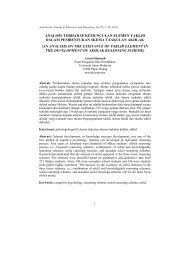
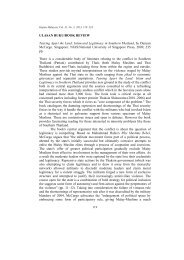

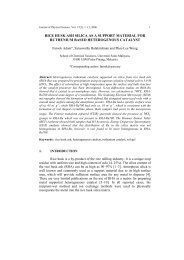

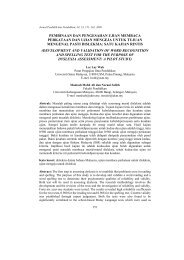
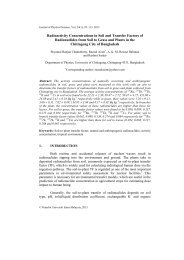
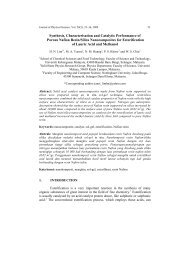

![KTT 111 – Inorganic Chemistry I [Kimia Takorganik I] - USM](https://img.yumpu.com/12405642/1/184x260/ktt-111-inorganic-chemistry-i-kimia-takorganik-i-usm.jpg?quality=85)
